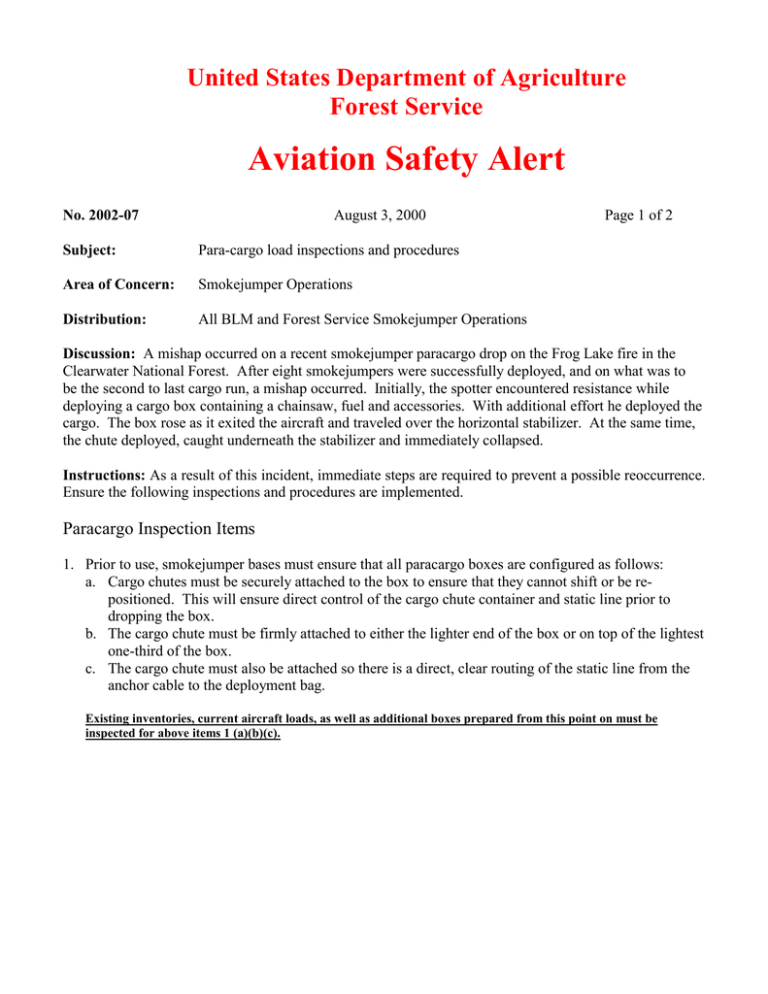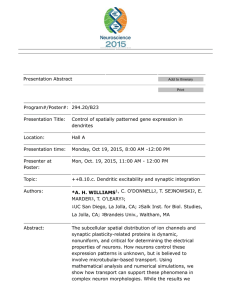Aviation Safety Alert United States Department of Agriculture Forest Service
advertisement

United States Department of Agriculture Forest Service Aviation Safety Alert No. 2002-07 August 3, 2000 Subject: Para-cargo load inspections and procedures Area of Concern: Smokejumper Operations Distribution: All BLM and Forest Service Smokejumper Operations Page 1 of 2 Discussion: A mishap occurred on a recent smokejumper paracargo drop on the Frog Lake fire in the Clearwater National Forest. After eight smokejumpers were successfully deployed, and on what was to be the second to last cargo run, a mishap occurred. Initially, the spotter encountered resistance while deploying a cargo box containing a chainsaw, fuel and accessories. With additional effort he deployed the cargo. The box rose as it exited the aircraft and traveled over the horizontal stabilizer. At the same time, the chute deployed, caught underneath the stabilizer and immediately collapsed. Instructions: As a result of this incident, immediate steps are required to prevent a possible reoccurrence. Ensure the following inspections and procedures are implemented. Paracargo Inspection Items 1. Prior to use, smokejumper bases must ensure that all paracargo boxes are configured as follows: a. Cargo chutes must be securely attached to the box to ensure that they cannot shift or be repositioned. This will ensure direct control of the cargo chute container and static line prior to dropping the box. b. The cargo chute must be firmly attached to either the lighter end of the box or on top of the lightest one-third of the box. c. The cargo chute must also be attached so there is a direct, clear routing of the static line from the anchor cable to the deployment bag. Existing inventories, current aircraft loads, as well as additional boxes prepared from this point on must be inspected for above items 1 (a)(b)(c). Page 2 of 2 2. Static lines should be stowed on the cargo parachute deployment bag in a manner that will not allow them to partially deploy in the aircraft. In the case where static lines are stowed in pouches on the top of the deployment bag, small rubber bands should be used to secure 2-3 bights of static line together. An Alliance size 27 rubber band or its equivalent would be adequate. The rubber band on all bights should be double wrapped. 3. Smokejumper bases should ensure that chainsaw boxes are packed compactly enough to provide a maximum weight-to-surface area, as well as ensuring a clean surface with no protrusions. Packing the saw with the bar not attached to the power head will allow both of these considerations to be met. Spotter Cargo Dropping Procedures 1. Spotters shall maintain direct physical control of all cargo chute deployment bags until the cargo box is physically discharged from the aircraft. 2. Spotters shall be able to have an unobstructed view of the static line from its attachment on the aircraft anchor cable to the cargo chute deployment bag. Any excess static line should be re-stowed in the deployment bag prior to the drop. 3. When discharging cargo boxes, they should be pushed down and out from the aircraft to avoid sailing in the slipstream. If the weight is not evenly distributed in the box, the box should be placed in the door so the heavy end goes out first. Special care should be taken when discharging cargo from roller tracks to ensure that the boxes leave the aircraft in a downward trajectory. For additional information or clarification, contact Pat Wilson at the Missoula Technology and Development Center, 406-329-1015 Morgan H. Mills Acting, National Aviation Safety and Training Manager




